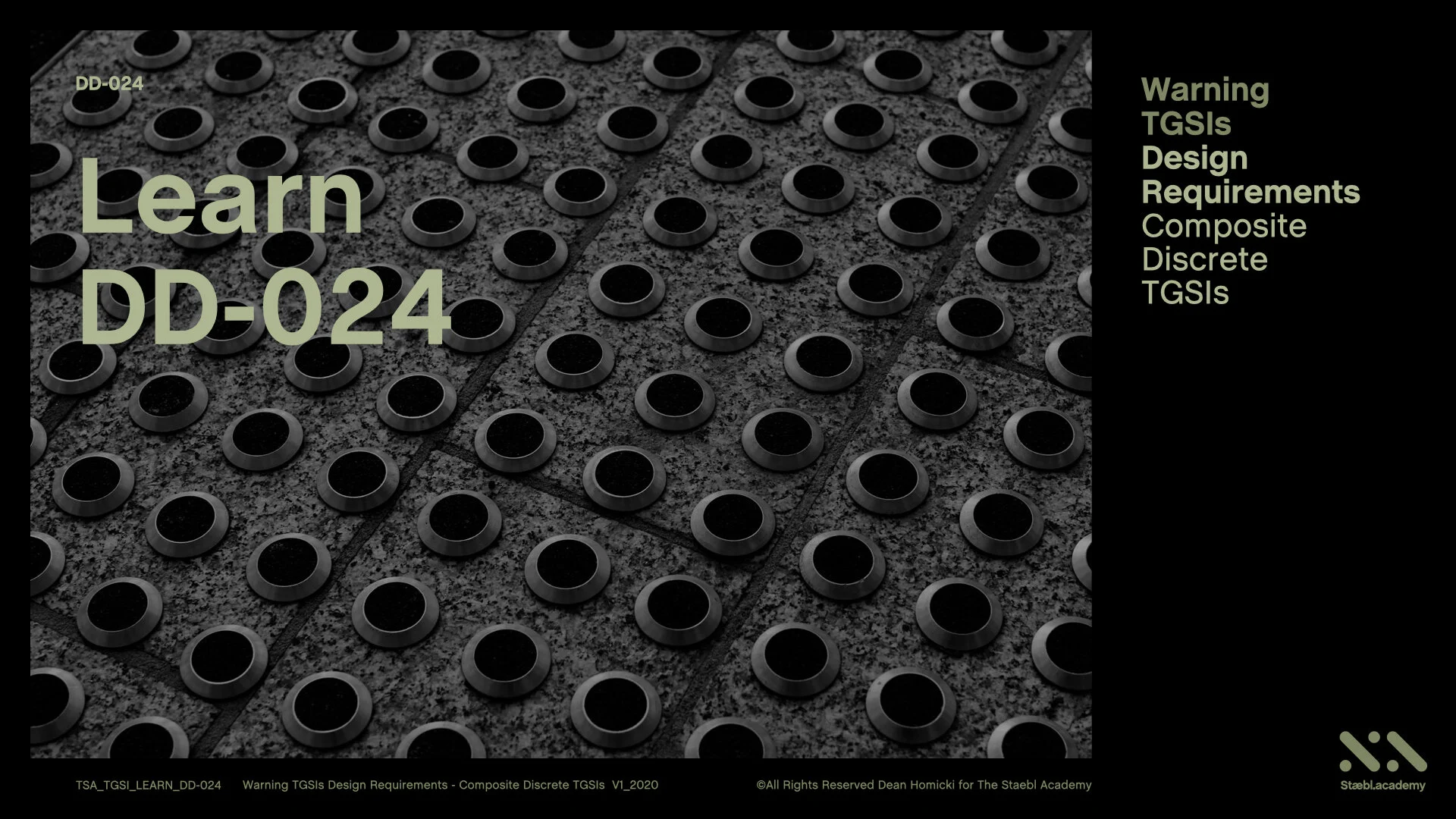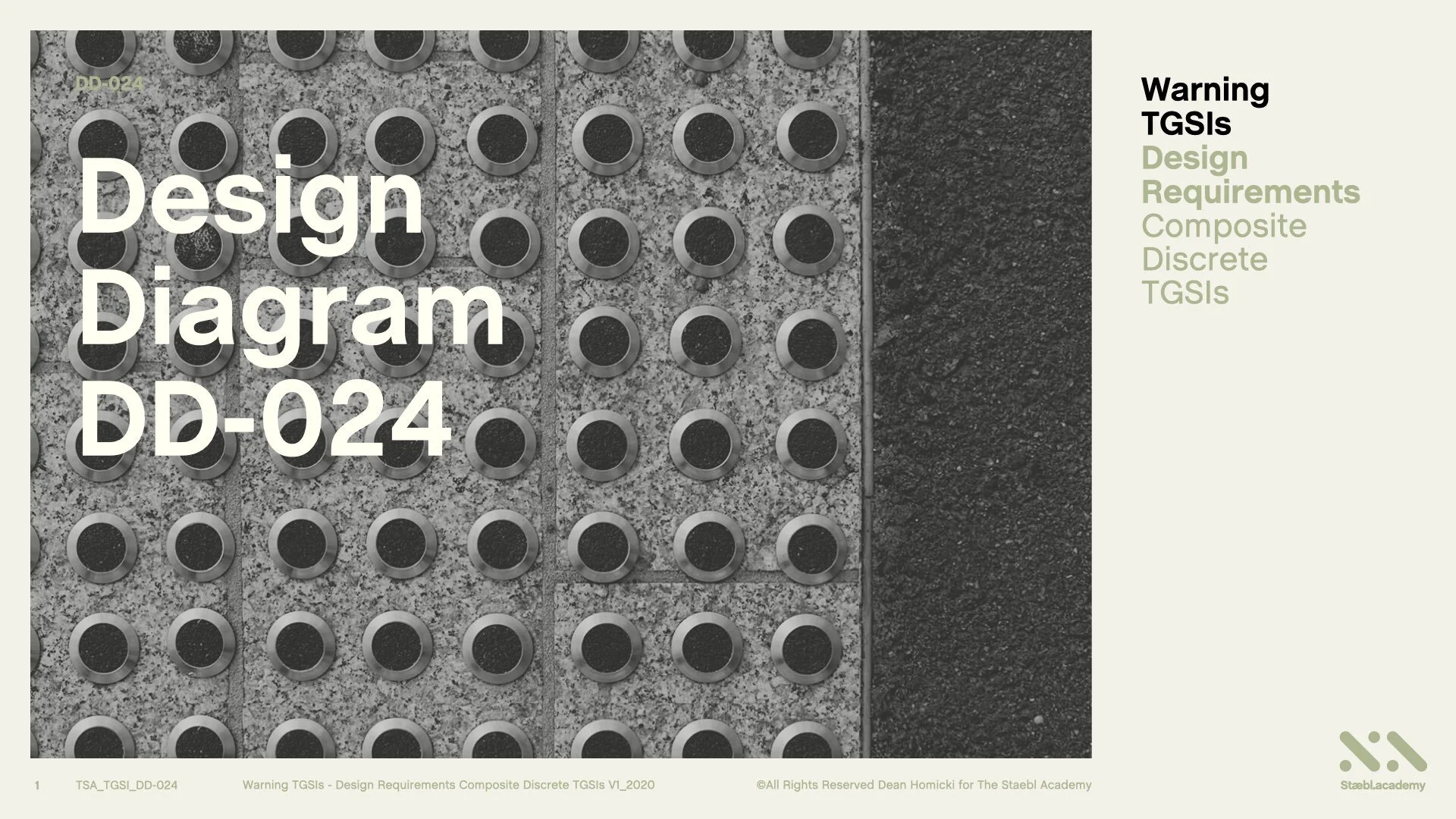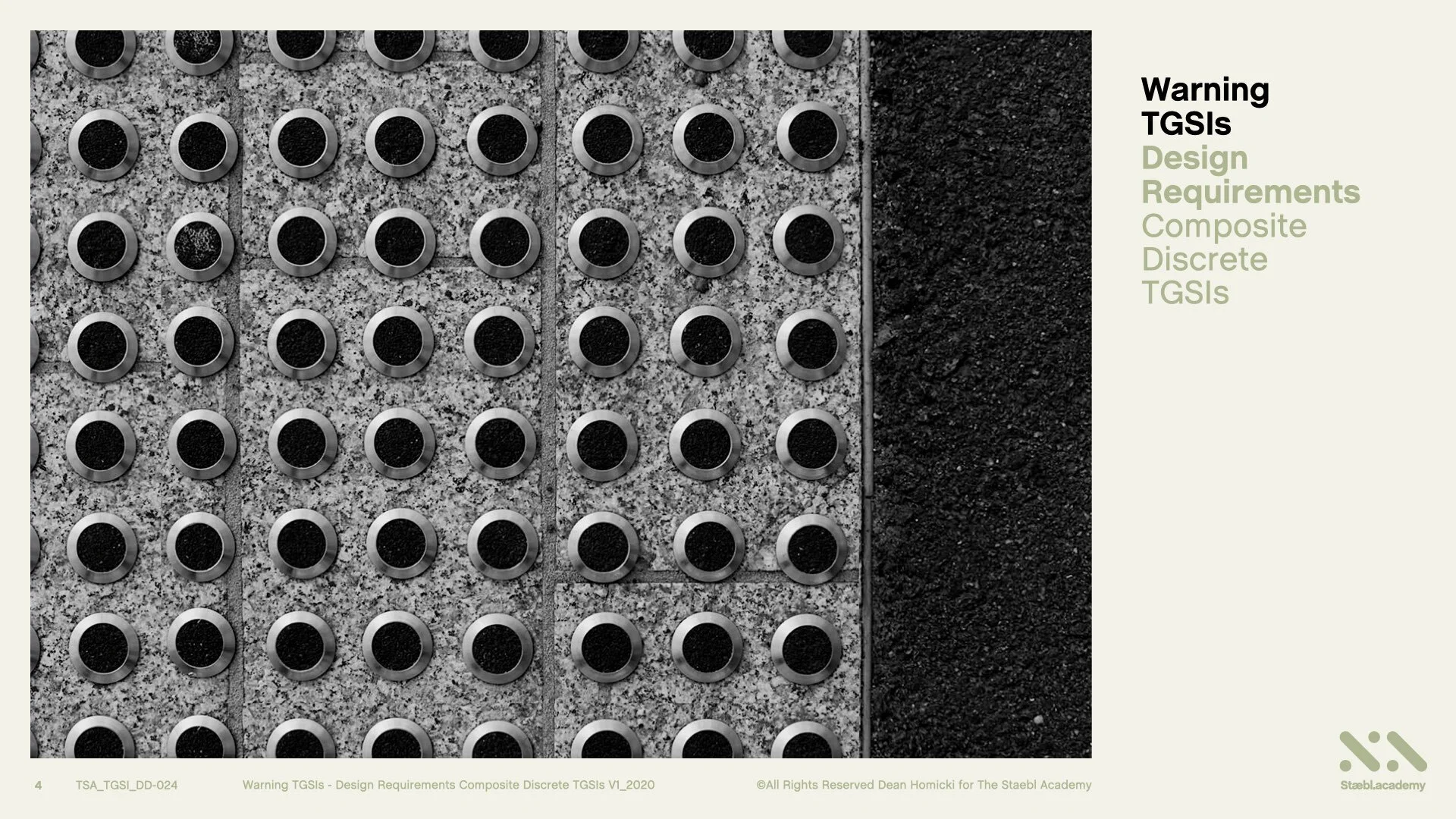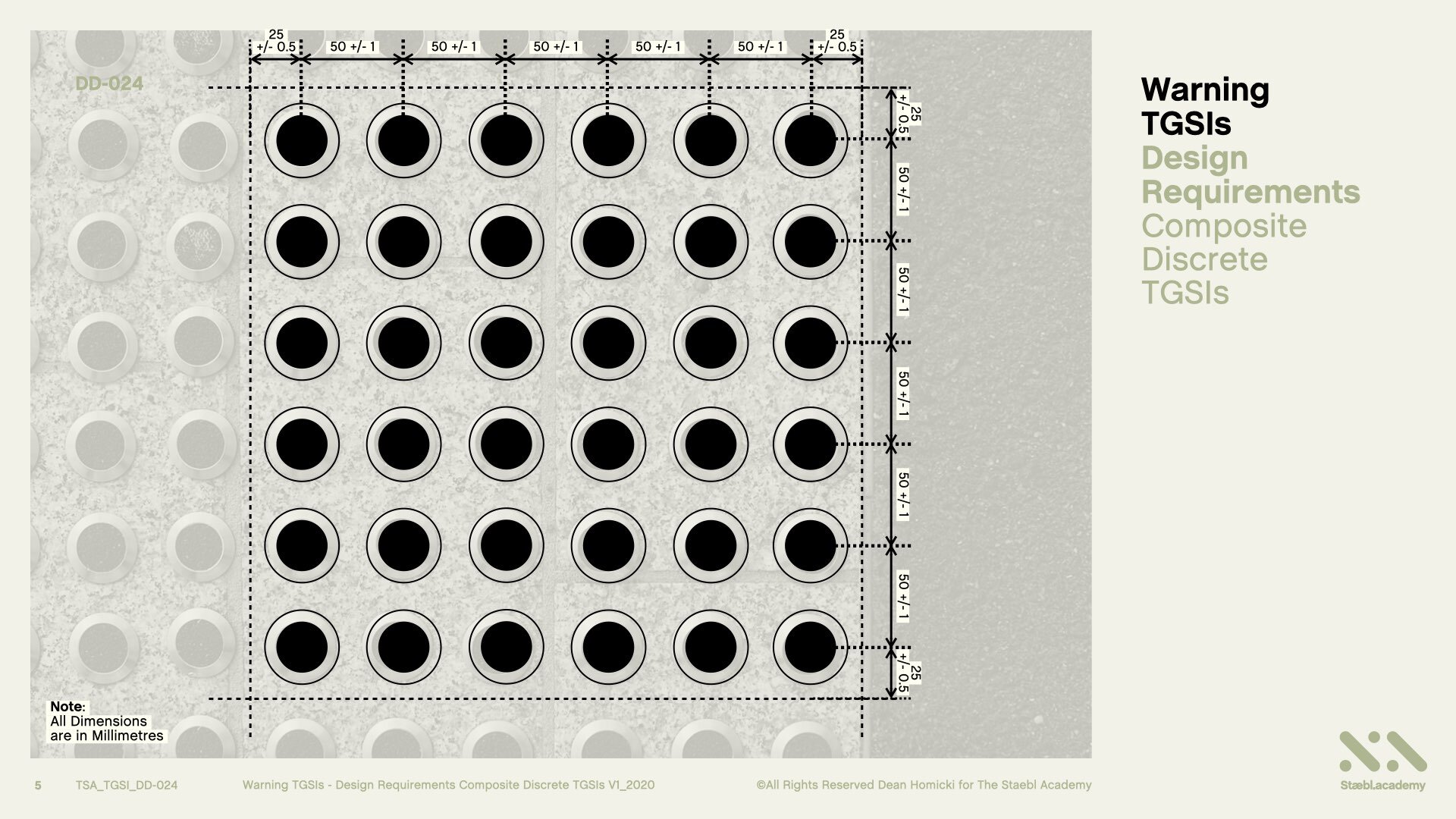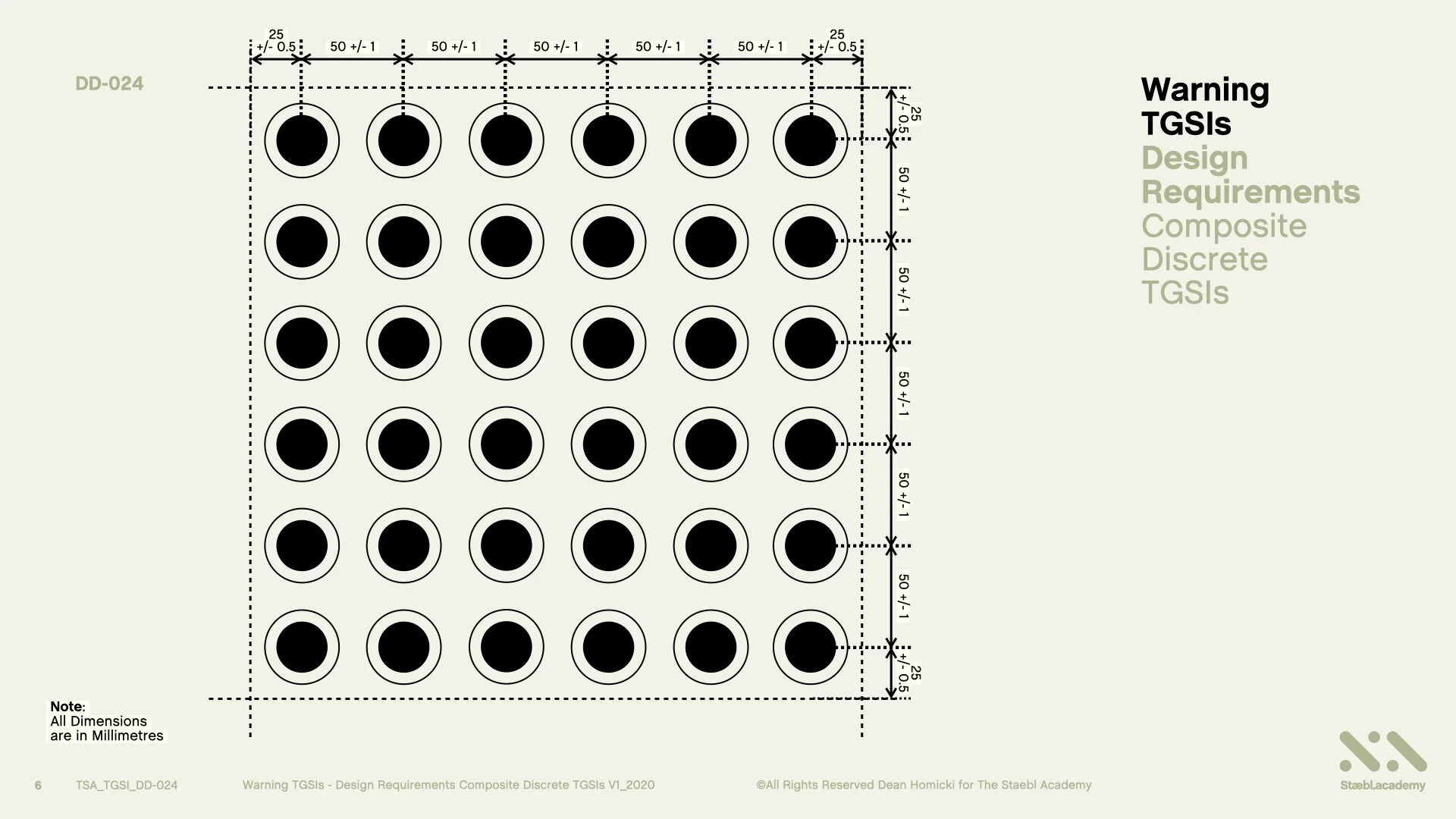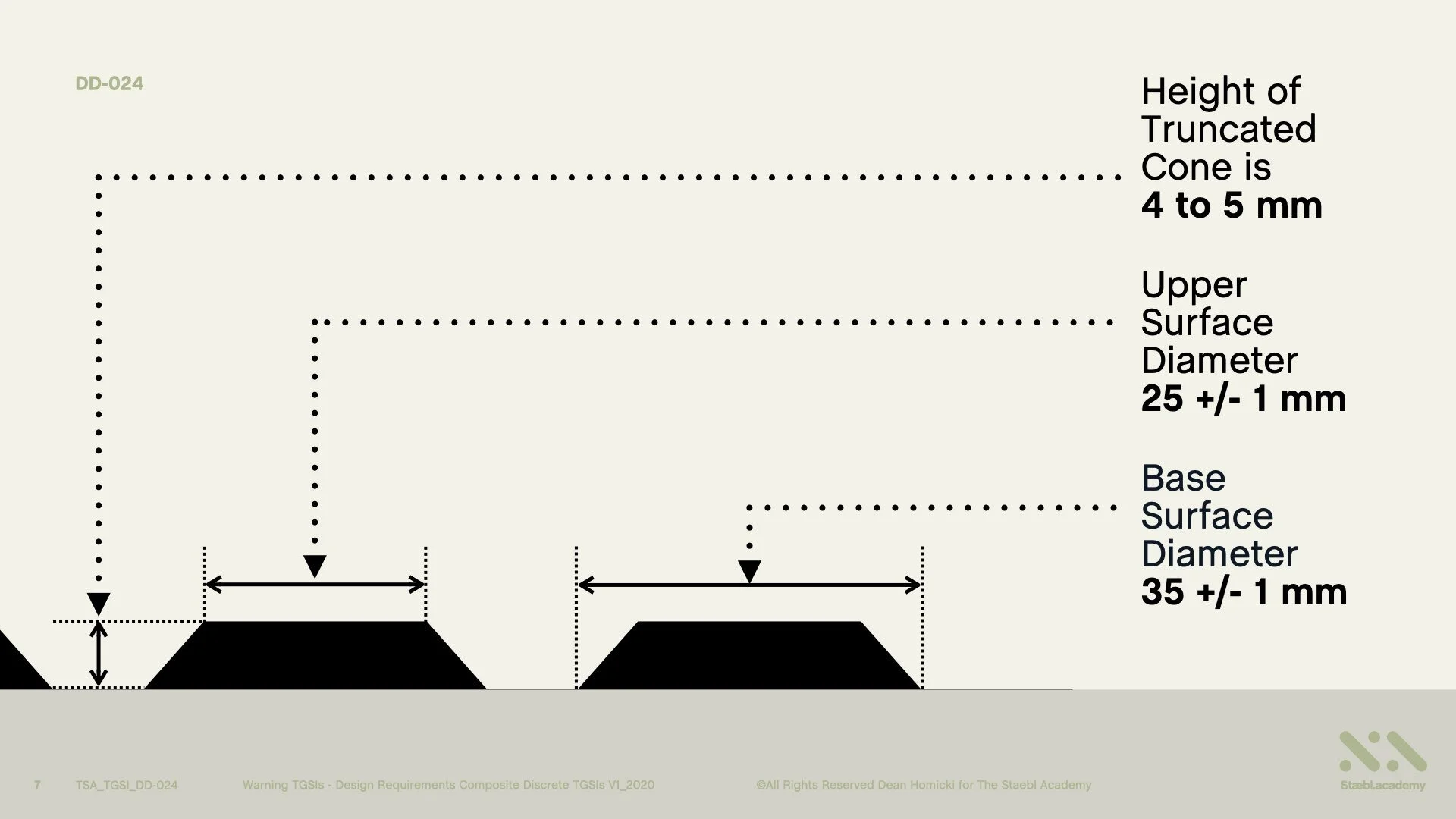TGSI Design Requirements
Composite Discrete Warning TGSIs
Course: DD-024 | Length: 5:47 mins | Instructor: Dean Homicki
Chapters
00:26 - Learning Overview
01:24 - Learning Session
01:41 - Let’s Begin
05:11 - Learning Resources
Transcript
This learning session will cover the use of:
Warning TGSIs and the Design Requirements for Composite Discrete TGSI Types.
Welcome to staebl.academy TGSI Design Diagram 024. I’m Dean Homicki and I’ll be your guide for this course.
Learning Overview
We begin by asking,
‘How are Composite Discrete TGSIs defined in the Australian TGSI Standard?’
The Australian TGSI Standard describes a Composite Discrete TGSI as, ‘Tactile Ground Surface Indicators (TGSIs) that are individually installed, which provide a differing luminance for the sloping sides, and the upper surface of the truncated cone.’
What are the Design requirements of Composite Discrete TGSIs?
There are two types of Composite Discrete TGSIs. These types are defined as Composite Discrete Warning TGSIs and Composite Discrete Directional TGSIs.
In this learning session, we will review Composite Discrete Warning TGSIs.
Learning Session
Let’s take a closer look at the technical details outlined in Figure 2.1, Amendment No.2, of the Australian TGSI Standard. A summarised version of these requirements follows herein.
Let’s Begin.
The Truncated Cones of Composite Discrete Warning TGSIs, shall each have,
a height of: 4 to 5 mm above the entire Base Surface,
have a diameter at each base of: 35 +/- 1 mm,
have a diameter at each Upper Surface of: 25 +/- 1 mm and,
each be evenly spaced apart in a defined pattern (Arrangement) of 50 +/- 1 mm,
measured from the centre of each Truncated Cone.
Each Composite Discrete Warning TGSI must have, Luminance-Contrast to the background, or, the adjacent Path of Travel as follows:
Composite Discrete: Not less than 60% Luminance Contrast, measured from the upper surface of the Truncated Cone for a diameter of 25 +/1 mm.
Each Composite Discrete Warning TGSI unit shall be slip-resistant.
In Australia, to determine a TGSI’s slip-resistance rating and it’s classification, the trafficable surface of the TGSI needs be tested in accordance with AS 4586: 2013 and, installed in conjunction with Standards Australia Handbook HB 198: 2014 - Guide to the specification and testing of slip resistance of pedestrian surfaces.
Let’s take a look at the dimensionality of Composite Discrete Warning TGSIs.
We begin with a real-life installation of 316 Stainless Steel Composite Discrete Warning TGSIs. We are going to now convert this image into a Plan view line drawing and reveal the dimensionality of the TGSI Arrangement (Pattern). Here’s the line drawing of the image.
The Truncated Cones are evenly spaced apart in a defined pattern (Arrangement) of 50 +/- 1 mm. These are measured from the centre of each Truncated Cone to the centre of the adjacent Truncated Cone. The Truncated Cones must also be parallel to each other. When Composite Discrete Warning TGSIs are installed together, (side-by-side) or (end-to-end), it is important that the 50 +/- 1 mm spacing between each of the Truncated Cone is maintained.
To determine the arrangement (Pattern) for the Width of a Composite Discrete Warning TGSI installation, a distance of 25 +/- 1 mm, is measured from the centre of the Upper Surface of the Truncated Cone, to locate the perimeter edge. This dimension should be observed to ensure conformance to the many installation criteria of TGSIs.
These measurements will also achieve the correct arrangement (Pattern) of Composite Discrete Warning TGSIs with Figure 2.1 of the Australian TGSI standard.
In an Elevation View of the Composite Discrete Warning TGSIs, we can see that, the Height of each Truncated Cone is 4 to 5 mm, that the Upper Surface Diameter of is 25 +/- 1 mm, and that the Base Surface Diameter 35 +/- 1 mm. The Truncated Cones of Composite Discrete Warning TGSIs, shall each have a height of: 4 to 5 mm above the entire Base Surface, have a diameter at each base of: 35 +/- 1 mm, have a diameter at each Upper Surface of: 25 +/- 1 mm, and each be evenly spaced apart in a defined pattern (Arrangement) of 50 +/- 1 mm, measured from the centre of each Truncated Cone.
Each Composite Discrete Warning TGSI must have, Luminance-Contrast to the background, or, the adjacent Path of Travel as follows: Composite Discrete: Not less than 60% Luminance Contrast, measured from the upper surface of the Truncated Cone for a diameter of 25 +/- 1 mm.
Each Composite Discrete Warning TGSI unit shall be slip-resistant. In Australia, to determine a TGSI’s slip-resistance rating and it’s classification, the trafficable surface of the TGSI needs be tested in accordance with AS 4586: 2013 and, installed in conjunction with Standards Australia Handbook HB 198: 2014 - Guide to the specification and testing of slip resistance of pedestrian surfaces.
Let’s take a look at the dimensionality of Composite Discrete Warning TGSIs.
We begin with a real-life installation of 316 Stainless Steel Composite Discrete Warning TGSIs. We are going to now convert this image it into a Plan view line drawing and reveal the dimensionality of the TGSI Arrangement (Pattern). Here’s the line drawing of the image.
The Truncated Cones are evenly spaced apart in a defined pattern (Arrangement) of 50 +/- 1 mm. These are measured from the centre of each Truncated Cone to the centre of the adjacent Truncated Cone. The Truncated Cones must also be parallel to each other. When Composite Discrete Warning TGSIs are installed together, (side-by-side) or (end-to-end), it is important that the 50 +/- 1 mm spacing between each of the Truncated Cone is maintained.
To determine the arrangement (Pattern) for the Width of a Composite Discrete Warning TGSI installation, a distance of 25 +/- 1 mm, is measured from the centre of the Upper Surface of the Truncated Cone, to locate the perimeter edge. This dimension should be observed to ensure conformance to the many installation criteria of TGSIs.
These measurements will also achieve the correct arrangement (Pattern) of Composite Discrete Warning TGSIs with Figure 2.1 of the Australian TGSI standard.
In an Elevation View of the Composite Discrete Warning TGSIs, we can see that, the Height of each Truncated Cone is 4 to 5 mm, that the Upper Surface Diameter of is 25 +/- 1 mm, and that the Base Surface Diameter 35 +/- 1 mm.
Learning Resources
That’s the conclusion for the Design Requirements of Composite Discrete Warning TGSIs.
You can also access this course as a concise series of design diagrams in the resource section of our website staebl.academy/design. To access this resource now, click on the link below this video.
Thanks for joining me here at the staebl.academy. I look forward to guiding you through another learning session in the near future. Bye for now.
Listen
Click/Tap the audio player below to listen to the written transcript of this design session as an audible version. This is a streamed broadcast from the Staebl.academy site.
Diagrams
Click/Tap on an image from this learning session to view it as a larger picture. You will then be able to scroll through each individual design diagram in this slide-deck for a closer inspection.
Sources
TSA-TGSI-LEARN-DD-023 - This staebl.academy course module has drawn information from the following sources:
AS/NZS 1428.4.1: 2009 (Amendments 1 & 2) Design for Access and Mobility: Means to assist the orientation of people with a vision impairment - Tactile Ground Surface Indicators - Clause 1.4.8 (AMDT No. 1 NOV 2010), Section 2, 2.2 (b) & (b i & ii), 2.3.1 (c) & (d), Section 3, 3.2 General Requirements, 3.2.2 Design Requirements, 3.2.3, Fig 3.1 (a), (b) & (c) AMDT No.1 NOV 2010, Appendix E.E2 Luminance Contrast Requirements - 1st and 4th Paragraph, Appendix A1 Wayfinding (b).


